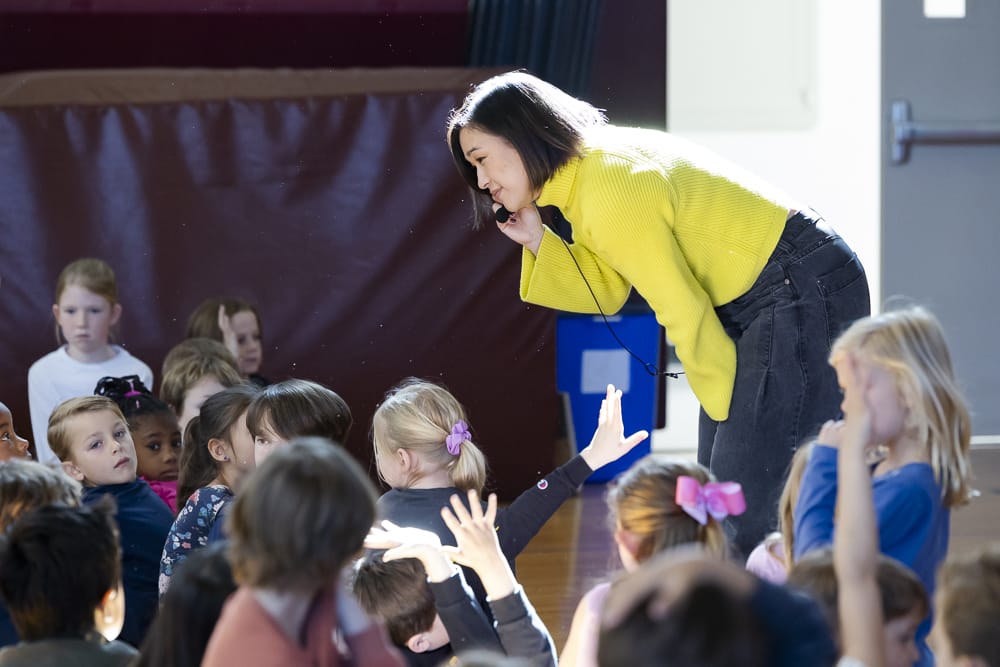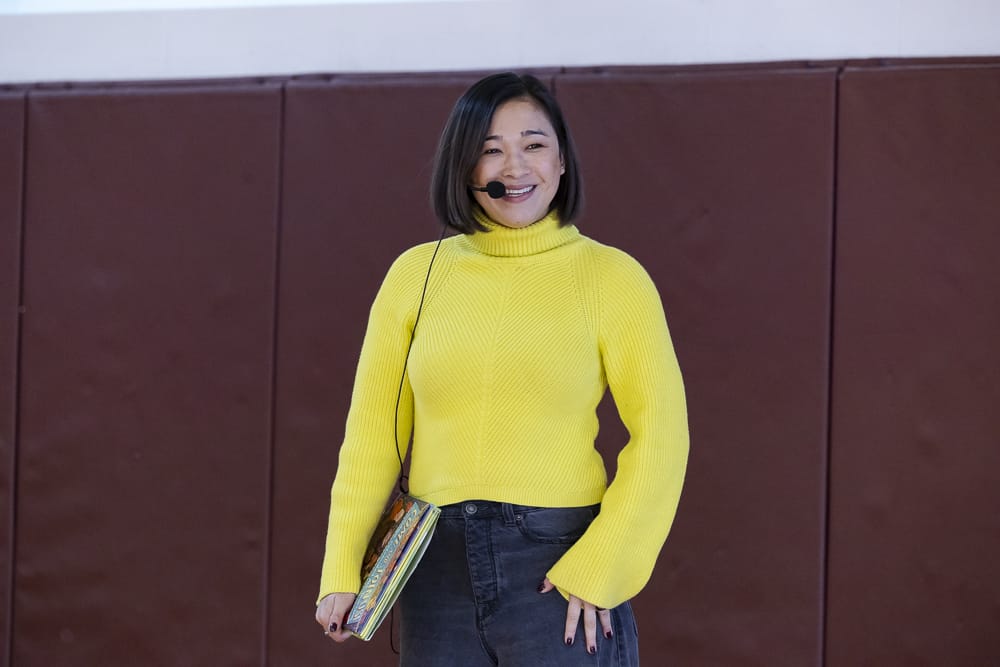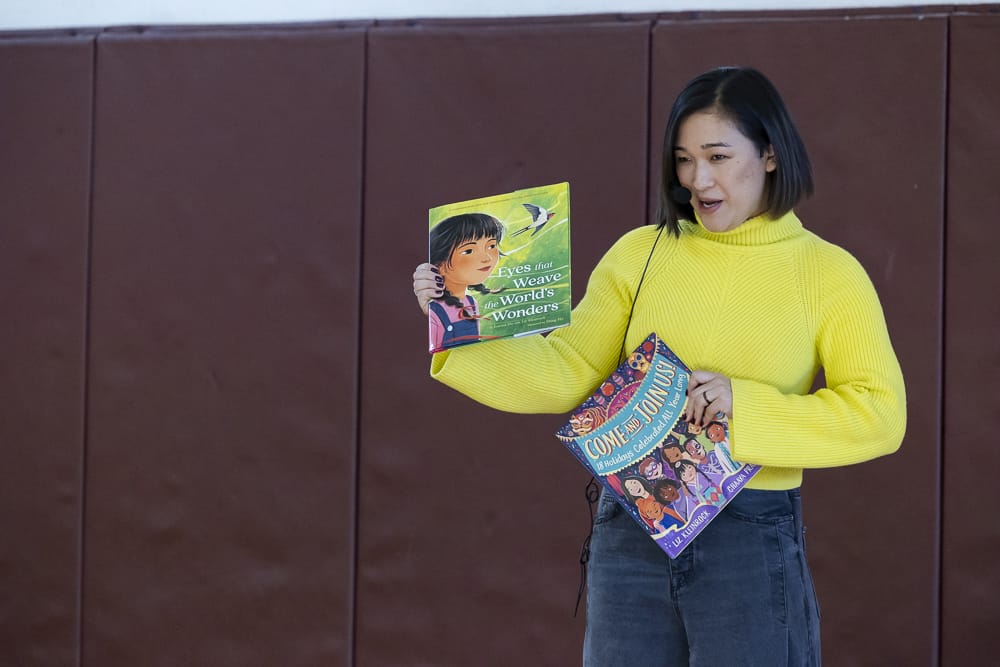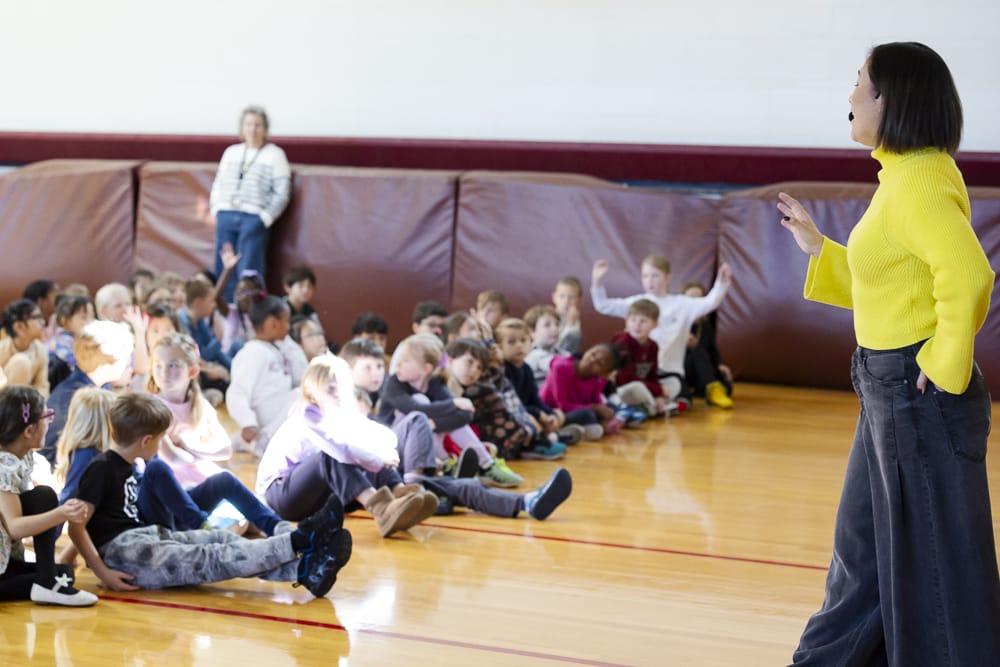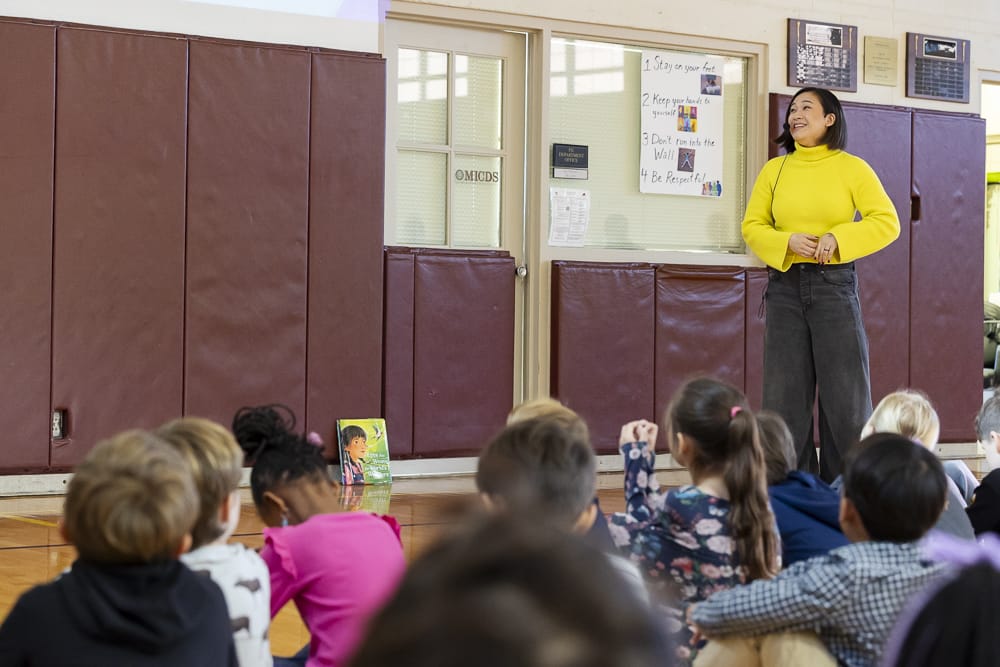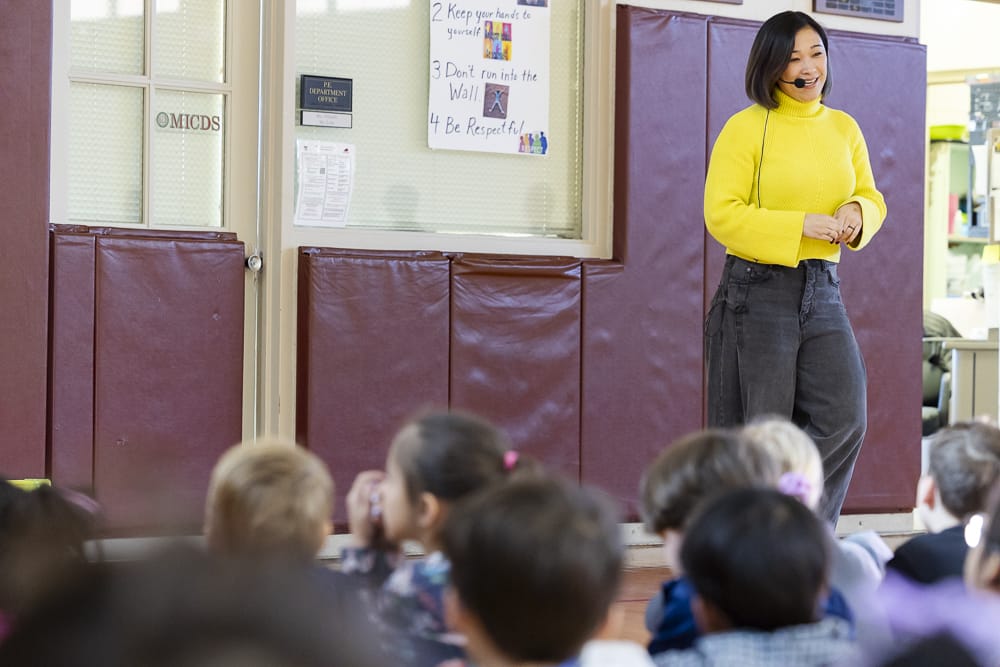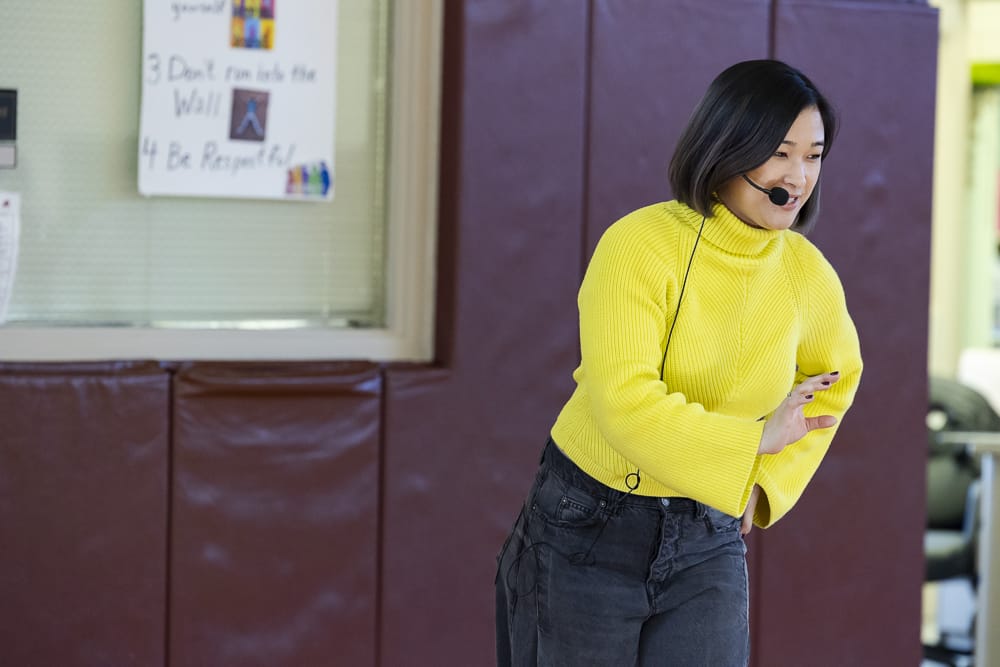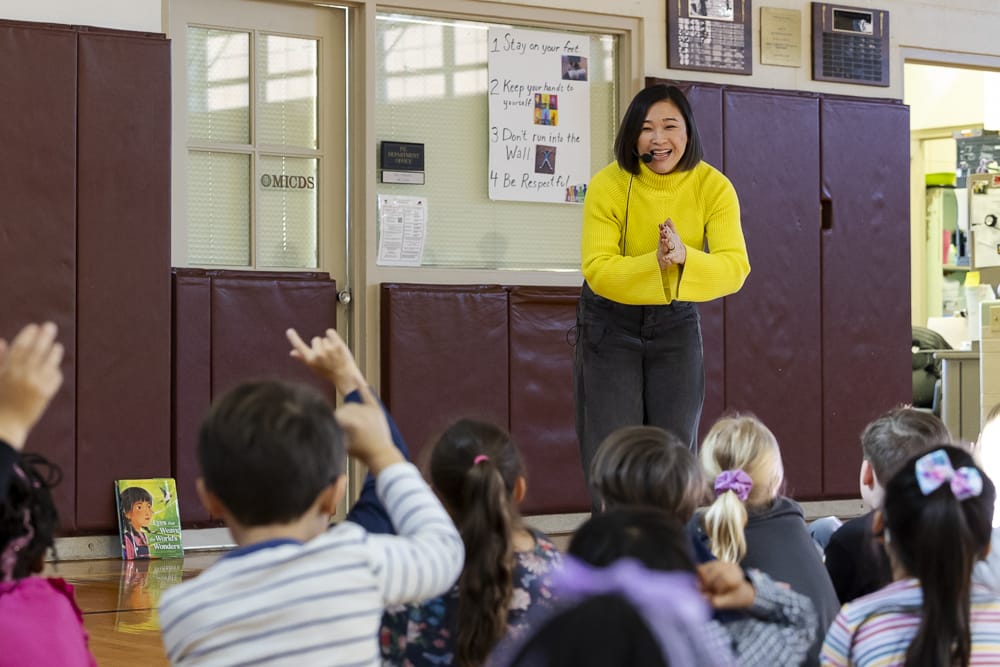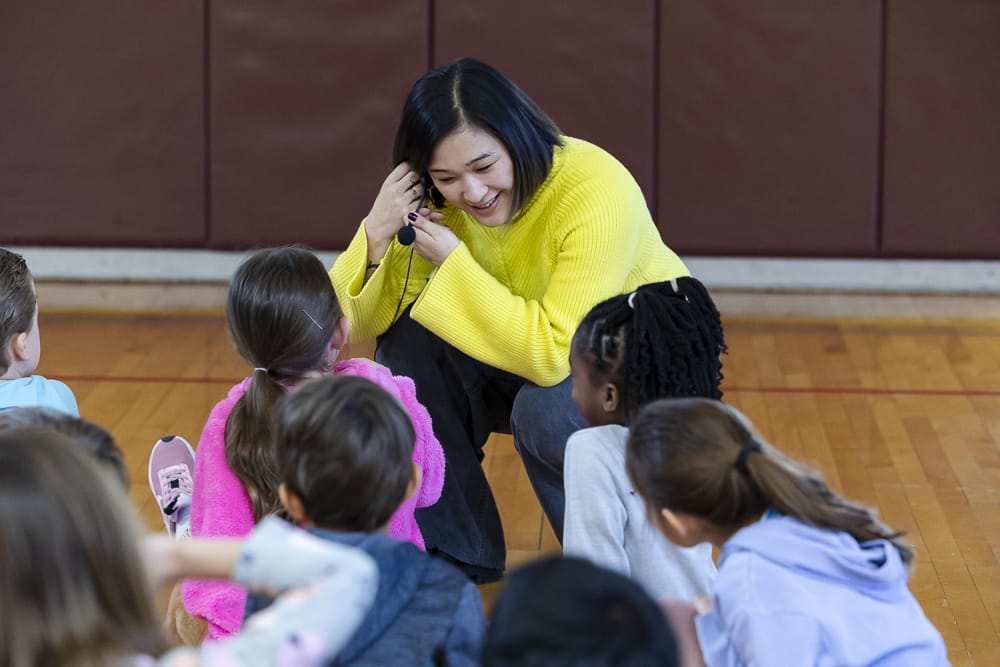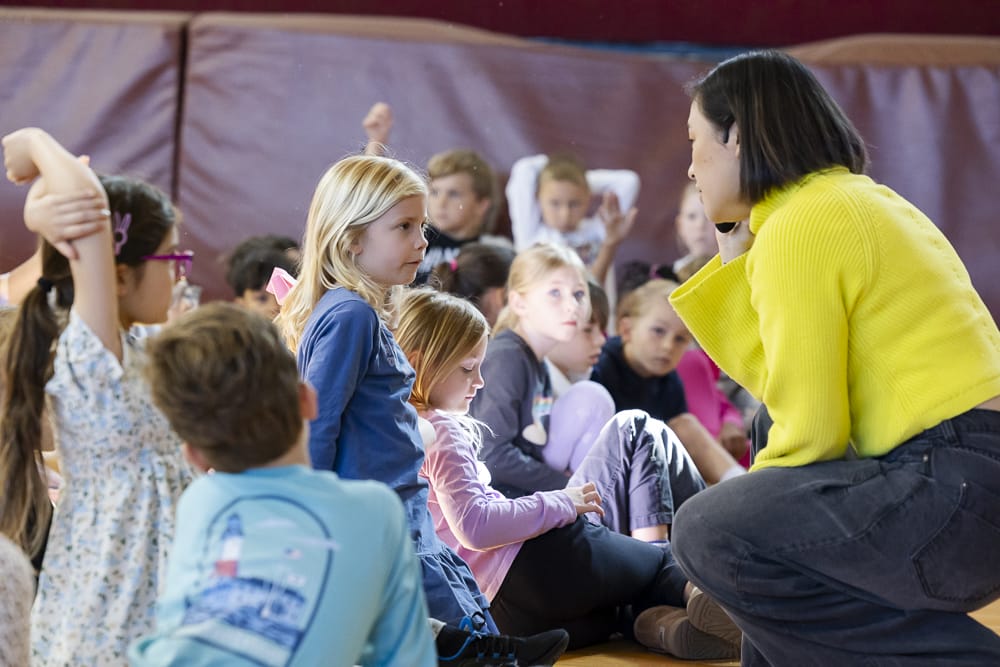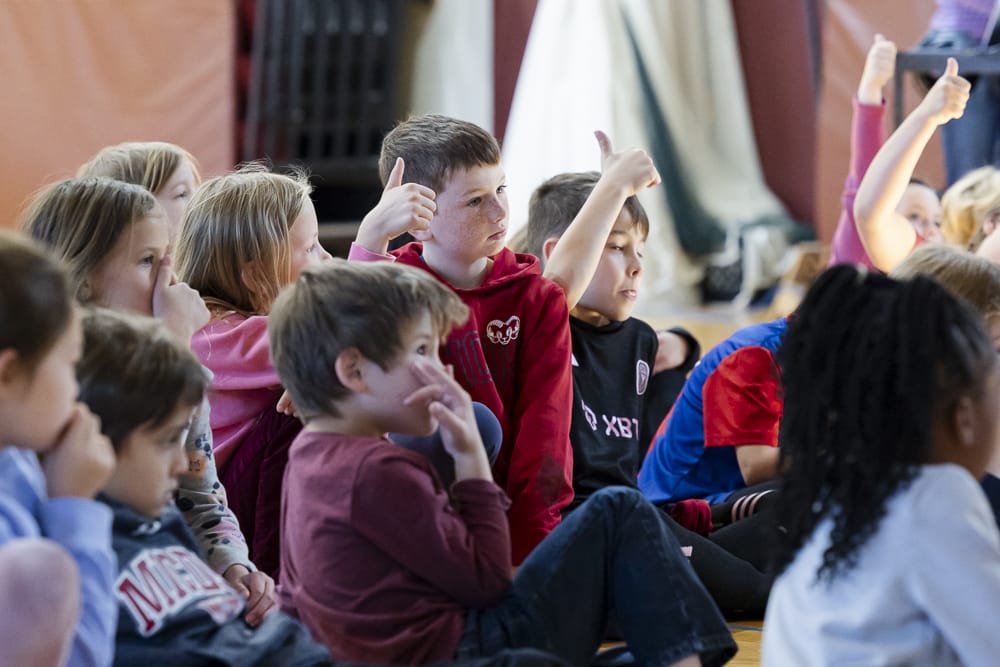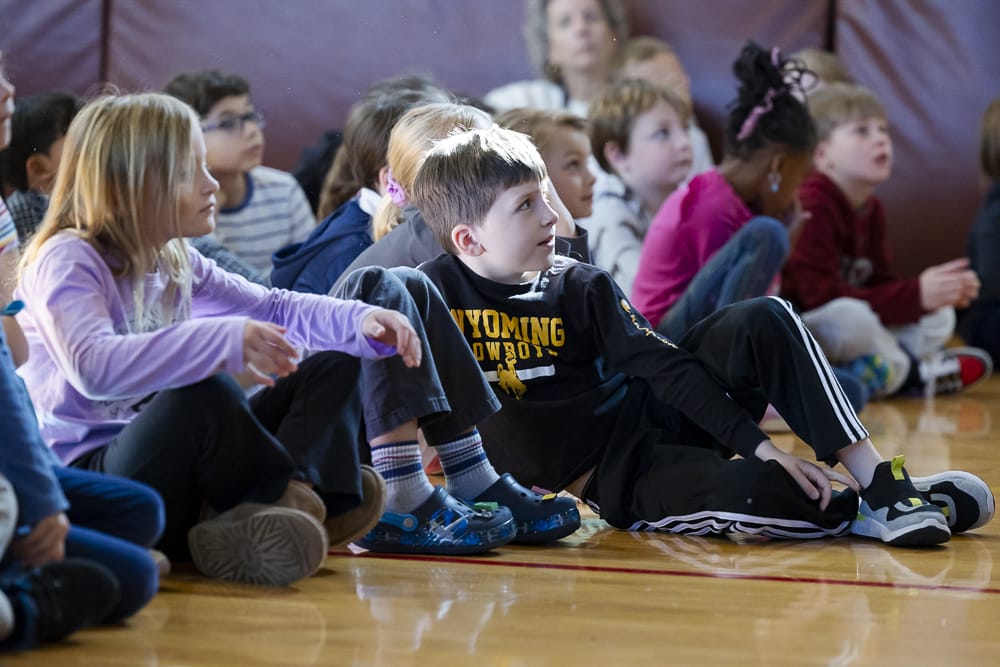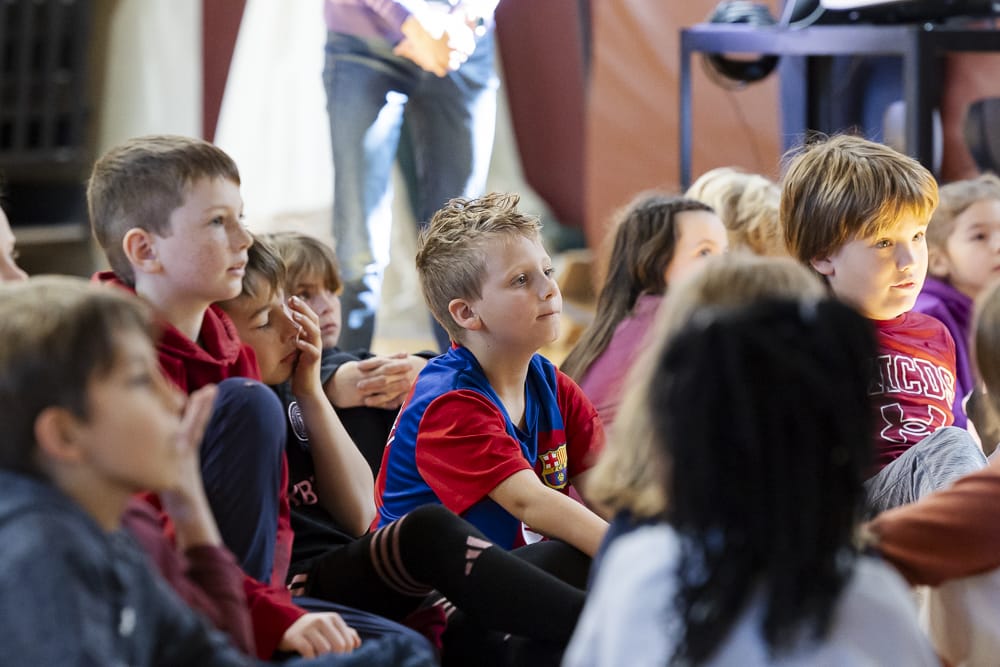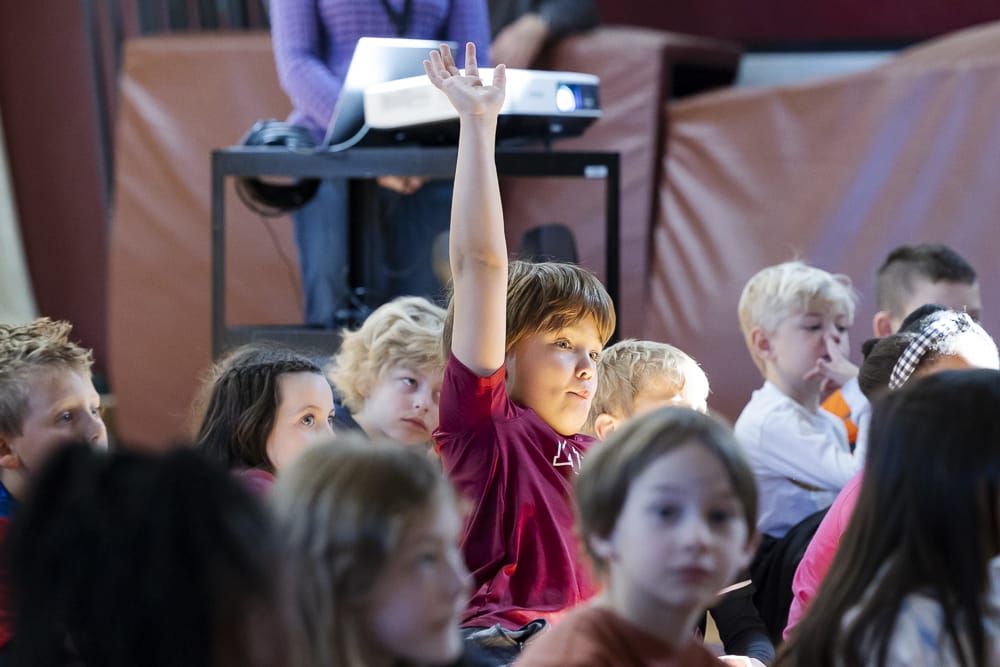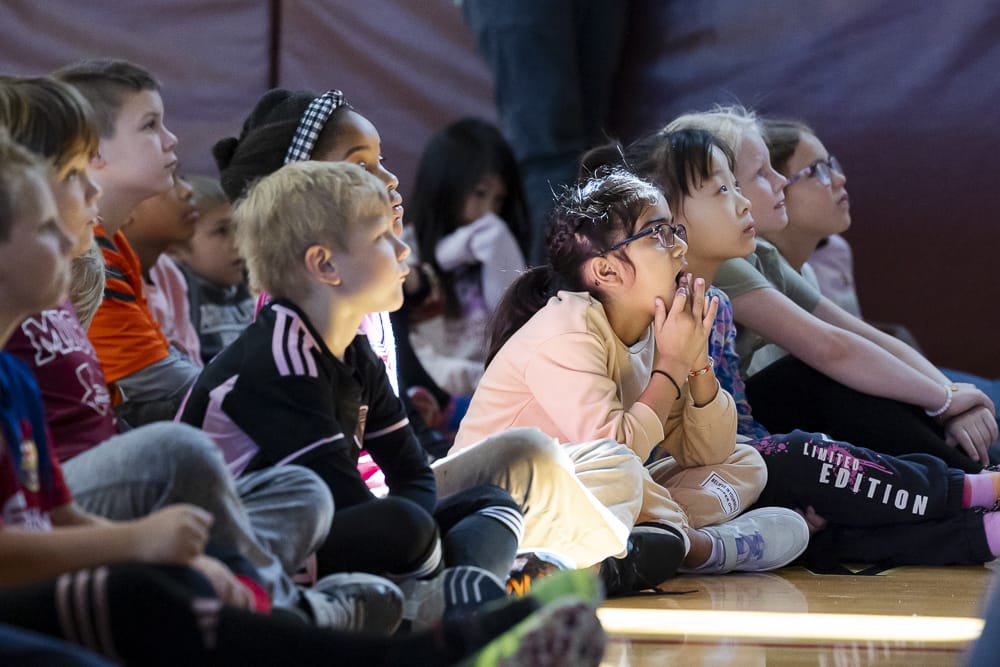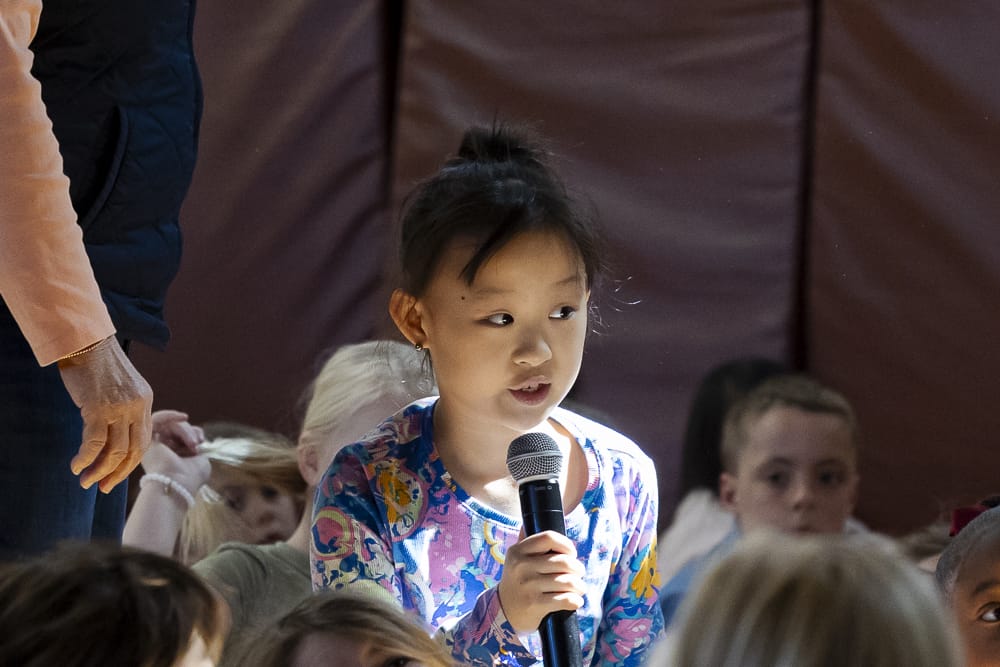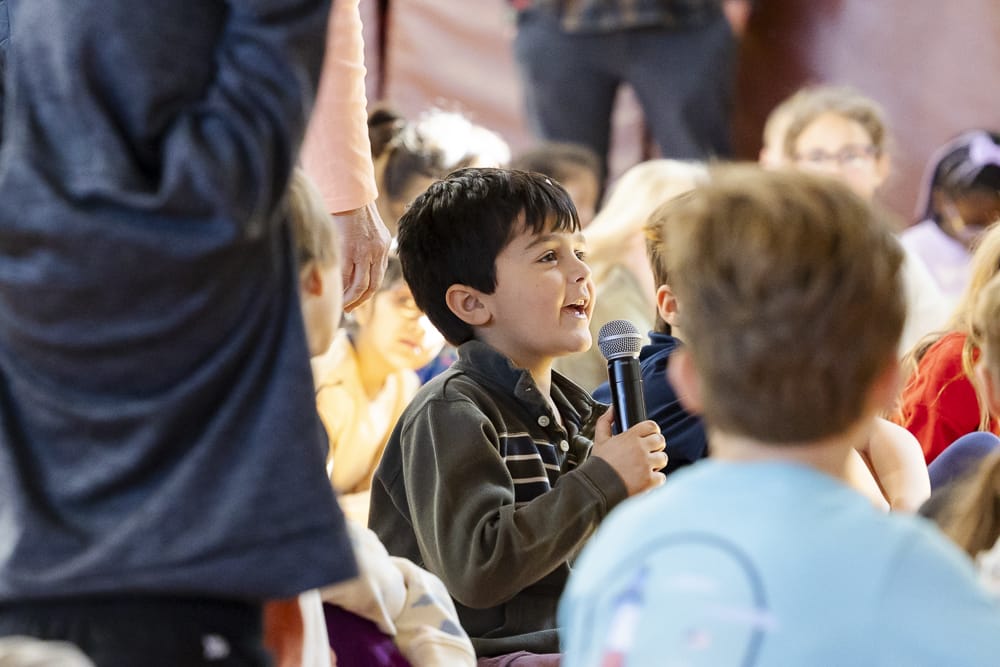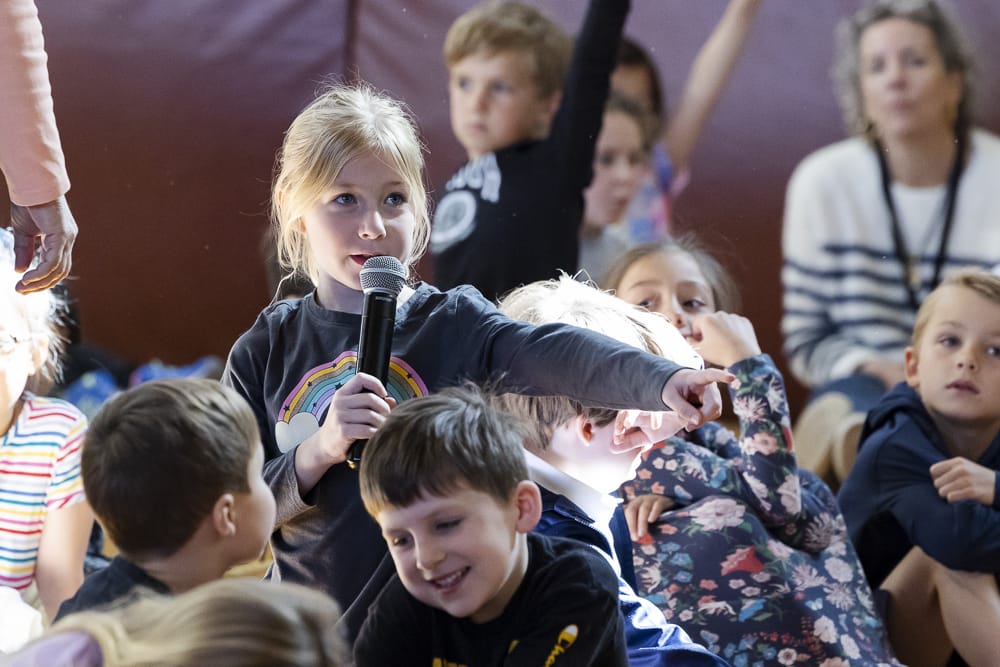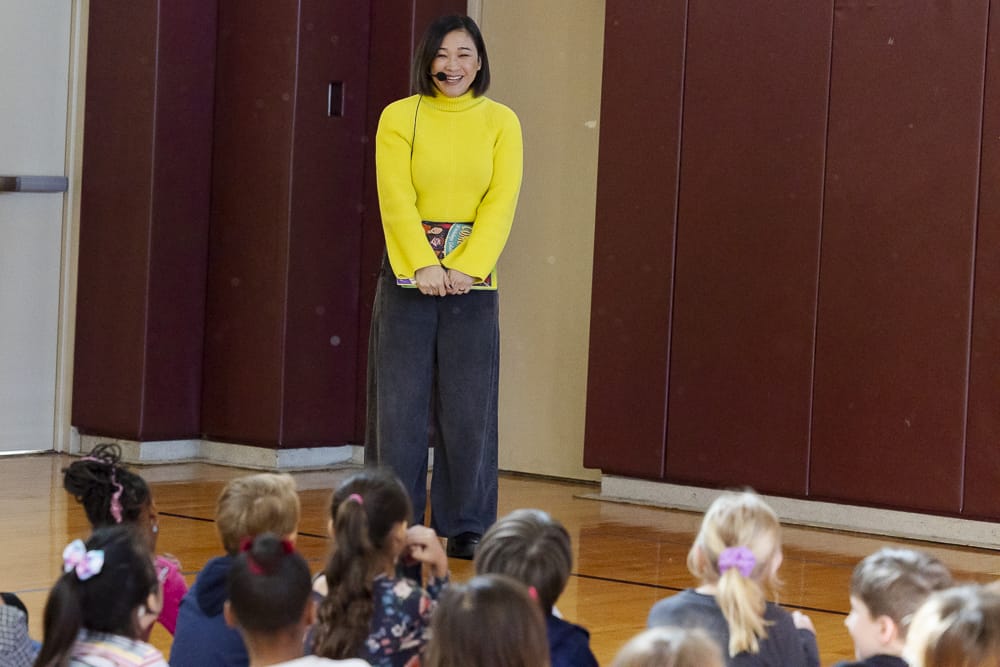It’s pretty exciting when students get to meet an author whose books they enjoy, and earlier this month, we were thrilled to welcome author Liz Kleinrock to MICDS. Our first- and second-grade students, who have been reading Kleinrock’s Eyes That Weave The World’s Wonders, got to spend time with her in the South Gym.
Kleinrock co-wrote, with fellow author Joanna Ho, a book that shares her story as a transracially adopted Korean Jewish American. She set about writing the book because she realized that, out of all the books in the world, there wasn’t one that mirrored her own experience.
She began by introducing herself to the students. “There are different things that make you who you are. I have a lot of different identities that are all inside me all at the same time. I am an adoptee, I am also Korean—born in a country called Korea, which takes about 12 hours on an airplane to get there from here. I identify as Asian American. My adoptive family is Jewish, so I was raised Jewish. And I am queer.” Kleinrock has been a teacher, working in every grade of elementary school, a librarian, a director of DEBI, and a creative writing teacher. She earned her undergraduate degree from Washington University right here in St. Louis (and was looking forward to getting some Ted Drewe’s while she was back in town!).
“My favorite thing to do is to watch scary movies,” she said to the students, before asking them if they like scary movies. Lots of hands went up. “You are my people!” she laughed. “If I’ve had a really long week or day at school, I come home and can be focused on what’s happening in the scary movie, then I don’t have the brain space to think about work or what’s happening, so it’s really fun,” she said. Then she asked if the students love animals, and was delighted by the overwhelming response. “I have three pets at home,” she shared. “I have two bunnies, Blue and Epiphany. They are very cute and fluffy and not very friendly. I also have a cat named Bruce. The cat and the bunnies get along really well; they hang out together. Bruce likes the bunnies more than he likes other cats.” She also shared that she loves to go fishing. “I grew up fly fishing with my dad and grandpa, and we still do that together.” Finally, she said, “I love, love, love to read.”
This was a great segue into her next question. “Can you think of a book or TV show or movie where you have seen parts of yourself, what you or your family look like, or something you’ve done before, reflected in that book? That’s a book being like a mirror. When you look in a mirror, you see you.” She talked about how books can be like windows, and when you read a book, you are looking into another world, learning about people and experiences different than our own. Some books are mirrors, where readers can see themselves reflected back in what they are reading. And other books are sliding glass doors, where readers can go in and out of their stories.
“This made me think a lot about when I was younger,” she said. “I wondered, what are the books in the world that are mirrors for me, where I see myself and my family and my experience being adopted reflected in this way? I couldn’t think of anything.” That’s when she knew she had to write a book about her own experience and what it felt like being a transracial adoptee.
“What does it mean for someone to be an adoptee?” she asked. Many hands went up. One student said that it’s when a child might be born into one family and then raised somewhere else. Another student said parents might try to add or build onto their family by bringing another child in, even if they aren’t related. And sometimes people have children, and they can’t afford them or aren’t able to take care of them. “There are lots of reasons why children are adopted,” said Kleinrock. She showed a variety of photos from her childhood, including one from the first time her parents met her, when she was five months old. “My family doesn’t have hospital photos; we have airport photos instead. I arrived in Washington in 1987 on the very first night of Hanukkah.”
She shared that she had a wonderful childhood filled with love and support. And yet, looking different from the rest of her family brought challenges. She explained that this is what a trans-racial adoption means versus an adoption where the child looks like the family they join.
“Growing up, I was the only student in my class who was adopted. I had friends and classmates who were curious about why my family looked different than their families. I don’t think they ever meant to hurt my feelings; they were just curious. Because I didn’t have a lot of answers or language to talk about it, it made me sad and uncomfortable. ‘Why don’t you look like your parents?’ ‘Where is your real family?’ ‘Why didn’t your parents want you?’ ‘How much did you cost?’ ‘I bet you feel very lucky.'” Sometimes her peers would gripe about their family, saying, “My siblings and parents are so annoying. I wish I was adopted, too.'” As if adoptees don’t ever find their siblings and parents annoying!
In a search to find answers to these questions, Kleinrock realized that while adoption is frequently depicted across a variety of media, the stories are often distorted and unrealistic. She pointed out a variety of stories, including Roald Dahl’s Matilda, the musical Annie, movies such as The Blind Side and Despicable Me (which make adoption seem much simpler than it really is), the horror movie called Orphan, and even the Harry Potter series. “I see themes and messages that make me uncomfortable,” she said, and pointed out that adoptees are often viewed as mysterious and even creepy because their origin isn’t known.
“When I talk to classes, or talk to my students, or do visits, people say, ‘I know all about adoption because my family adopted a dog.’ Adopting animals is a very good thing, but it’s nowhere near the same as adopting a human into your family. Comparing myself to a dog or a cat does not feel very good,” she said.
Her book, Eyes That Weave The World’s Wonders, cowritten with author Joanna Ho and beautifully illustrated by artist Dung Ho, offers a moving look into what it means—and how it feels—to be a trans-racial adoptee. Kleinrock projected her book on the wall and started by pointing out that there’s an author’s note at the start. “You should always read the author’s note,” she said. “The author put it there for a reason.” She read the note, and then the book, to students and teachers. The gym was quiet, and the audience was entranced by the story and the art.
After the reading, Kleinrock welcomed questions from the students. There was no shortage of hands in the air, and she patiently listened to a variety of questions and answered them all.
Thank you, Liz, for spending time with our students and for sharing your story with the world! Thomas Buffington, Lower School Librarian, also expressed gratitude for Dean of Faculty Dr. Grace Lee’s work in facilitating Kleinrock’s visit both at MICDS and with other schools in St. Louis. Head of Lower School Amy Scheer, Lower School Library Associate Nicole Liebman, and the first- and second-grade teaching teams also supported this visit and the preparation that happened in the days before.
Want to see how our students learned about Kleinrock and her work? Visit these sites:
